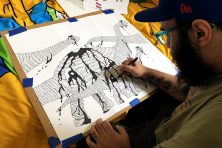This Guy Sells Drawings of Pizza and Sharks Online (and Earns $2,000/Month)

Abbas Husain always doodled. In the corners of notebooks, napkins, whatever he could find.
But he never imagined he could really make a living from it.
Even after studying art in college, he found himself working a series of corporate and restaurant jobs.
He was miserable. And at age 30, he decided he’d had enough. He started sharing the art that had been relegated to the depths of his imagination.
Sharks holding cakes. Dinosaurs wearing high heels. OctoCones.
And people ate it up. Husain now earns around $2,000 per month selling his art online at Bagman Studios.
Giving the ‘Adult World’ a Try
Though Husain focused on drawing and narrative arts in college — a decision that probably didn’t offer “the amount of value [he’s] still paying for” — he graduated unconvinced he could make money from art.
So he entered the “adult world”: He held a supervisory role at a T-shirt printing company, then eventually returned to manage the bar where he’d worked in college.
Nothing felt right.
“I should’ve always known I wouldn’t be happy if I wasn’t doing artwork,” he says. “But it took me kind of a while to figure out.”
In February 2016, he saw a way out.
His mom needed help moving out of her house — help he could provide in exchange for a free place to stay. He quit his job and headed home to make art; he just didn’t know which kind yet.
“I went to talk to my career guidance guy from art school,” he says. “His first piece of advice was ‘don’t quit your day job.’ I was like… ‘What’s the second piece?’”
Starting to Screen Print

At first, Husain focused on products: pins and hats, things he “thought people would need.” Then, on the side, he experimented with screen prints to “satiate” his creativity.
“I knew how it worked in theory, but I had never actually printed anything before,” he explains. “It was a pretty frustrating couple months. I messed up a lot of prints… a lot of prints.”
Luckily, his overhead costs were fairly low. He spent approximately $300 on supplies like screens and ink, and then rented studio time at a local print shop for $12 per hour.
He “got better with each and every print,” and one day in August, randomly posted one of his images on Reddit. It was of sharks sitting in a movie theater — and much to his surprise, people went crazy over it.
“It really blew up,” he says. “That kickstarted my site and shifted what I wanted to do. So instead of trying to create a line of products, I started concentrating on my own craft and making weird prints.”
Balancing Creativity and Clients
From there, he kept marketing his business through Instagram and his website — and thanks to the uniqueness of his art, “started to build a pretty good following on the internet.”
Despite that, he’s kept his prices low, calling that a “core” part of his business.
“I’ve seen prints my size going for $20-$25, but I think $15 is a pretty fair place for them,” he says. Each design is handmade and has a limited run — usually just 100 prints.
He supplements that income with the freelance clients who trickled in as his online reach grew.
The scope of the projects ranges greatly: from a major gig with a greeting card company to “weird small stuff” — like the recent commission to draw a man, his girlfriend, an elephant and a giraffe.
For basic pen-and-marker drawings, Husain charges as little as $100, but for bigger assignments, he typically starts around $400-$500.
“I’ve gotten a lot better at making sure I only take projects I want to do,” he says. “I have a good amount of people who ask for logo design, and I don’t enjoy [that]. So I try to focus on illustration.”
Between prints and client work, Husain grosses about $2,000 per month. And though he works full time and now has his own place, it’s far from a 9-to-5.
“I sort of work at the whims of my creativity,” he says. “Some days I’ll play video games; some days I’ll draw for 14 hours if I’m in the zone.”
3 Tips for Aspiring Artists

Over the past two years, Husain has learned a lot.
Here’s some of his advice for aspiring artists who want to get paid to draw:
1. Start small
Early in his business, Husain made the mistake of spending $800 to print thousands of custom pizza stickers.
“In my head, I was like ‘Oh people will definitely buy these’ — and hardly anyone did,” he says.
So when it came to T-shirts, he started small by using Printful, a service that prints your designs on-demand and ships them to the customer for you.
Though he loved Printful’s products, as well as its ability to integrate with his Shopify site, he recently switched to Merch by Amazon so he could offer Prime shipping.
2. Create marketable products
Husain attributes much of his success to the fact his products are affordable and consumable.
“My stuff is pretty weird and friendly and not terribly pretentious,” he says. “It’s very easy-to-digest pop art.”
The size of his art is also purposeful: 8.5” x 11” prints are inexpensive to print and mail.
Husain strongly believes “you shouldn’t lower the cost of your work if it’s good” — which is part of the reason he hasn’t tried to sell larger or more expensive pieces yet.
“I don’t think it’s sustainable to sell big stuff all the time,” he says. “Find a way to make cheap prints or turn [your art] into a product people can consume.”
3. Push yourself
Throughout his entrepreneurial journey, Husain says only one thing has remained consistent: “People will respond to stuff that’s good — and that you put work into.”
So, despite the fact screen printing can be “tedious,” he says his customers love “the fact it’s handmade and limited edition.”
With that in mind, he encourages artists to push themselves, saying: “There are so many opportunities to get better in your own work.”
If you want to improve at a particular skill, he recommends watching YouTube tutorials or using a site like Pluralsight to learn Adobe Photoshop or Illustrator.
Staying True to Himself

“People can tell when something’s disingenuous,” says Husain.
Which is why he’s determined to remain true to himself in his art — and his approach to business.
“This year, my biggest goal was to not have to wear pants that are more serious than sweatpants,” he says.
“I’ve only had to wear jeans for about 20 minutes, and that was on the way to the store to buy a new pair of sweatpants. So, so far the year is going great — except for those 20 minutes.”
Susan Shain is a freelance writer and digital nomad. She covers travel, food and personal finance (basically, how to save money so you can travel more and eat more). Visit her blog at susanshain.com, or say hi on Twitter @susan_shain.












